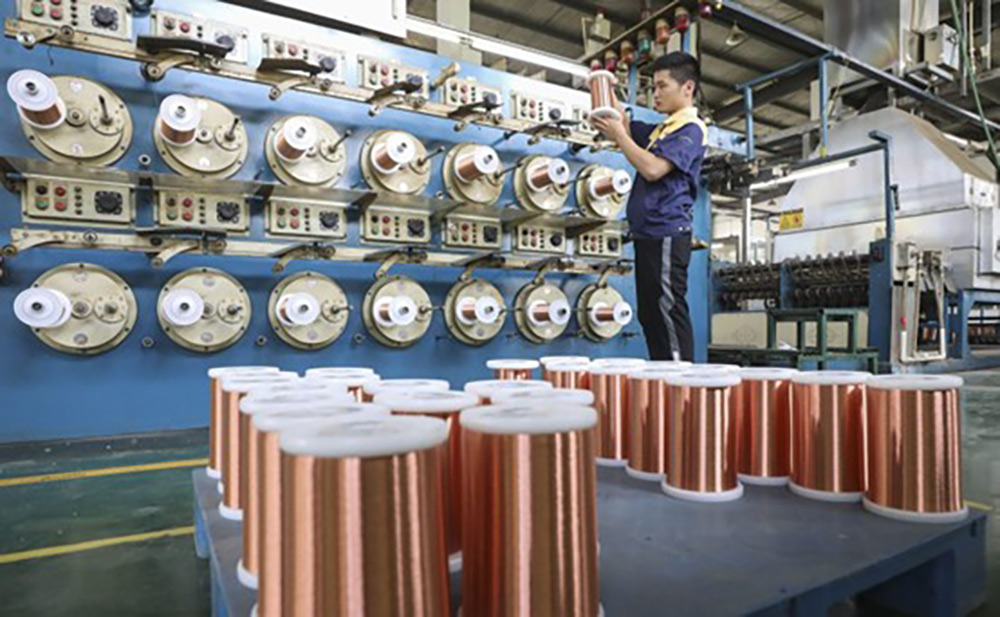
去年年初,俄乌冲突爆发后,随之而来的供应链混乱和西方制裁导致油价飙升,全球消费者几乎立即感受到这一影响。原油成本持续上涨,美国汽油平均价格从 1月份的每加仑3.40美元涨到6月份的每加仑略高于5美元的历史新高。但从那时起,在中国疫情后经济复苏低于预期,影响原油需求的情况下,石油和汽油价格又回落至俄乌冲突前的价格。而随着全球各国政府和企业继续摆脱对化石燃料的依赖,一种全新的、鲜为人知的商品可能会取代黑金而飙升。
“在花旗银行看来,铜是看涨能源转型交易。目前全球经济处于周期性疲软阶段,这意味着这一交易正处于暂停状态。但铜的最终牛市可能会使2008年油价的历史性飙升都相形见绌。”花旗银行大宗商品研究常务董事马克斯·莱顿在8月23日的客户视频演示中表示。
莱顿指的是全球金融危机爆发前油价飙升的时期,由于新兴市场需求强劲,而全球原油产量停滞不前,供不应求导致油价从2006年年中的每桶50美元涨至2007年底的每桶140美元。这位资深大宗商品分析师认为,未来三年铜价可能出现类似的上涨,因为铜已成为寻求能源转型主题敞口的大宗商品交易商的首选。
铜在电动汽车电池和其他绿色能源技术中发挥着关键作用,因此有人称其为“新石油”。这种金属可用于太阳能电池板、风力涡轮机、电缆,甚至你的iPhone。事实上,铜在建筑、制造业和电子产品生产中的应用广泛,以至于它经常被视为全球经济活动和商业周期指标,并因此获得了“铜博士”的绰号。
最近,随着全球经济在新冠肺炎疫情后艰难复苏,“铜博士”也敲响了警钟(铜价正在下跌),但如果你询问花旗银行对此的看法,该机构表示这对能源转型之王来说只是小挫折。
能源转型宠儿短暂受挫
由于全球经济增长放缓,铜这种关键金属的需求低于预期,铜价在2023 年出现暴跌。伦敦金属交易所(The London Metal Exchange)的现货铜价目前仅为8,359美元,较1月中旬每吨逾9,400美元的峰值下跌了11%。但花旗银行的莱顿认为,铜价回落可以带来机会。
花旗银行认为,由于铜价涨跌与全球经济活动走势保持一致,许多大宗商品交易商在买入铜之前不得不观望,等待全球经济形势好转,这就形成了买入铜的“大排长龙”现象。
莱顿表示,投资者在2023年下半年“谨慎”买入铜是明智的。
过去40年来,中国作为世界工厂,持续推动基础设施和住房项目的发展,使其在铜市场上占据了绝对优势。即使在中国房地产行业危机持续的情况下,2022 年中国仍然是全球最大的铜消费国,使用了全球供应量的55%。但在房地产市场和制造业萎靡不振的情况下,中国在2023年上半年仅进口了165万吨精炼铜,比去年同期减少了12%。
好消息是莱顿并不认为这种趋势会持续下去。他建议投资者在未来12个月内缓慢开始买入铜,认为能源转型和中国最终实现经济复苏将导致铜价在未来三年内飙升至每吨1.5万美元。“到2025年,预期回报率将达到50%至100%。”他在谈到这种“牛市情景”时表示。
不过,花旗银行在7月份的一份报告中也提及了看跌情景,即到2025年铜价可能下跌10%至7,500美元。美国和欧洲的利率上升将对全球经济增长产生“比预期更大的影响”,从而导致铜需求疲软。
不过,全球第八大铜生产商、波兰矿业巨头KGHM Polska Miedź的董事会在本月早些时候发布的第二季度财报中支持了花旗银行的看涨预期。
据KGHM称,从长远来看,随着中国经济复苏,个人电动交通工具(从汽车到电动自行车)的兴起以及能源转型将使全球对铜的需求持续上升。铜需求的不断增长,加上全球新采矿项目受到严重限制(包括增加税收和环保相关法规)导致供应有限,将使铜价在未来数年内持续走高。
KGHM董事会写道:“上述提及的铜供应限制,加上电动汽车的强劲趋势和推动铜需求增长的绿色革命,将在长期内支撑铜价。”(财富中文网)
译者:中慧言-王芳
去年年初,俄乌冲突爆发后,随之而来的供应链混乱和西方制裁导致油价飙升,全球消费者几乎立即感受到这一影响。原油成本持续上涨,美国汽油平均价格从 1月份的每加仑3.40美元涨到6月份的每加仑略高于5美元的历史新高。但从那时起,在中国疫情后经济复苏低于预期,影响原油需求的情况下,石油和汽油价格又回落至俄乌冲突前的价格。而随着全球各国政府和企业继续摆脱对化石燃料的依赖,一种全新的、鲜为人知的商品可能会取代黑金而飙升。
“在花旗银行看来,铜是看涨能源转型交易。目前全球经济处于周期性疲软阶段,这意味着这一交易正处于暂停状态。但铜的最终牛市可能会使2008年油价的历史性飙升都相形见绌。”花旗银行大宗商品研究常务董事马克斯·莱顿在8月23日的客户视频演示中表示。
莱顿指的是全球金融危机爆发前油价飙升的时期,由于新兴市场需求强劲,而全球原油产量停滞不前,供不应求导致油价从2006年年中的每桶50美元涨至2007年底的每桶140美元。这位资深大宗商品分析师认为,未来三年铜价可能出现类似的上涨,因为铜已成为寻求能源转型主题敞口的大宗商品交易商的首选。
铜在电动汽车电池和其他绿色能源技术中发挥着关键作用,因此有人称其为“新石油”。这种金属可用于太阳能电池板、风力涡轮机、电缆,甚至你的iPhone。事实上,铜在建筑、制造业和电子产品生产中的应用广泛,以至于它经常被视为全球经济活动和商业周期指标,并因此获得了“铜博士”的绰号。
最近,随着全球经济在新冠肺炎疫情后艰难复苏,“铜博士”也敲响了警钟(铜价正在下跌),但如果你询问花旗银行对此的看法,该机构表示这对能源转型之王来说只是小挫折。
能源转型宠儿短暂受挫
由于全球经济增长放缓,铜这种关键金属的需求低于预期,铜价在2023 年出现暴跌。伦敦金属交易所(The London Metal Exchange)的现货铜价目前仅为8,359美元,较1月中旬每吨逾9,400美元的峰值下跌了11%。但花旗银行的莱顿认为,铜价回落可以带来机会。
花旗银行认为,由于铜价涨跌与全球经济活动走势保持一致,许多大宗商品交易商在买入铜之前不得不观望,等待全球经济形势好转,这就形成了买入铜的“大排长龙”现象。
莱顿表示,投资者在2023年下半年“谨慎”买入铜是明智的。
过去40年来,中国作为世界工厂,持续推动基础设施和住房项目的发展,使其在铜市场上占据了绝对优势。即使在中国房地产行业危机持续的情况下,2022 年中国仍然是全球最大的铜消费国,使用了全球供应量的55%。但在房地产市场和制造业萎靡不振的情况下,中国在2023年上半年仅进口了165万吨精炼铜,比去年同期减少了12%。
好消息是莱顿并不认为这种趋势会持续下去。他建议投资者在未来12个月内缓慢开始买入铜,认为能源转型和中国最终实现经济复苏将导致铜价在未来三年内飙升至每吨1.5万美元。“到2025年,预期回报率将达到50%至100%。”他在谈到这种“牛市情景”时表示。
不过,花旗银行在7月份的一份报告中也提及了看跌情景,即到2025年铜价可能下跌10%至7,500美元。美国和欧洲的利率上升将对全球经济增长产生“比预期更大的影响”,从而导致铜需求疲软。
不过,全球第八大铜生产商、波兰矿业巨头KGHM Polska Miedź的董事会在本月早些时候发布的第二季度财报中支持了花旗银行的看涨预期。
据KGHM称,从长远来看,随着中国经济复苏,个人电动交通工具(从汽车到电动自行车)的兴起以及能源转型将使全球对铜的需求持续上升。铜需求的不断增长,加上全球新采矿项目受到严重限制(包括增加税收和环保相关法规)导致供应有限,将使铜价在未来数年内持续走高。
KGHM董事会写道:“上述提及的铜供应限制,加上电动汽车的强劲趋势和推动铜需求增长的绿色革命,将在长期内支撑铜价。”(财富中文网)
译者:中慧言-王芳
When Russia invaded Ukraine early last year, the subsequent supply-chain chaos and Western sanctions caused a spike in oil prices that consumers worldwide felt almost immediately. In the U.S., the rising cost of crude pushed the average price of a gallon of gasoline from $3.40 in January to a record high of just over $5 by June. But since then—amid a weaker-than-expected post-COVID recovery in China, which has impacted crude demand—oil and gasoline prices have fallen back toward prewar prices. And with governments and businesses globally continuing to move away from their reliance on fossil fuels, there’s a new, lesser-known commodity that may be set to soar instead of black gold.
“For us here at Citi, copper is the energy transition bull trade. The world is cyclically weak right now, and that means the trade is on pause. But copper’s eventual bull run is likely to make oil’s famous 2008 rally look like child’s play,” Max Layton, Citi’s managing director for commodities research, said in an Aug. 23 video presentation for clients.
Layton is referencing the period when oil prices spiked before the onset of the Global Financial Crisis, rising from $50 per barrel in mid-2006 to $140 per barrel by late 2007 as strong demand from emerging markets clashed with stagnant global crude production. The veteran commodities analyst believes that copper prices could see a similar price spike over the next three years because the metal has become a favorite among commodity traders looking for exposure to the energy transition theme.
Copper’s critical role in electric vehicle batteries and other green energy technologies has led some to call it “the new oil.” The metal is used in solar panels, wind turbines, electrical cables, and even your iPhone. In fact, copper is so widely used in construction, manufacturing, and electronics production that it’s often seen as a proxy for global economic activity and a business cycle indicator, earning it the nickname “Dr. Copper.”
Lately, with the global economy struggling to regain its stride after COVID, the doctor has been sounding the alarm (copper prices are falling), but if you ask Citi, it’s just a minor setback for the energy transition king.
The energy transition darling’s brief stumble
Copper prices have tumbled in 2023 amid weaker than forecast demand for the critical metal owing to slowing global economic growth. The London Metal Exchange’s cash copper price is now down 11% from its mid-January peak of over $9,400 per metric ton to just $8,359. But Citi’s Layton sees the pullback as an opportunity.
Because copper’s price tends to rise and fall in unison with global economic activity, many commodities traders have been forced to wait on the sidelines for global economic growth to improve before they can buy copper, creating a “massive queue” to buy the metal, according to Citi.
Layton said it makes sense for investors to be “cautious” about jumping into copper during the second half of 2023.
The country’s role as the world’s factory and continuous push to develop infrastructure and housing projects has given it an outsize position in the copper market over the past four decades. Even amid an ongoing crisis in the country’s property sector, China remained the biggest consumer of copper globally in 2022, using 55% of the world’s supply. But during the first six months of 2023, with its property market and manufacturing industry ailing, China imported just 1.65 million metric tons of refined copper, 12% less than it did a year ago.
The good news is Layton doesn’t expect the trend to last. He recommended investors slowly begin buying copper over the next 12 months, arguing that China’s eventual economic recovery and the energy transition will lead prices to surge to $15,000 per metric ton over the next three years. “Expected returns are a massive 50% to 100% by 2025,” he said of this “bull case” scenario.
However, Citi also outlined a bearish scenario where copper prices could fall 10% to $7,500 by 2025 in a July note. In this scenario, China’s economic recovery would be slower and less robust than expected, and rising interest rates in the U.S. and Europe would have a “larger than anticipated impact” on global growth, leading to weaker copper demand.
Still, the board of Polish mining giant KGHM Polska Miedź, the eighth largest copper producer globally, backed up Citi’s bull case outlook earlier this month in its second quarter earnings report.
But in the long run, as China’s economy recovers, the rise of electric personal vehicles—from cars to e-bikes—and the energy transition will keep demand for copper elevated globally, according to KGHM. And rising copper demand, coupled with limited supply owing to substantial constraints on new mining projects worldwide, including increased taxes and environmental regulations, should keep prices elevated for years to come.
“The aforementioned restrictions in supply, together with the strong trend towards electro-mobility and the green revolution spurring the pace of growth in demand for copper, will support copper prices in the long term,” KGHM’s board wrote.






